What to do if Mitsubishi Electric Inverter experiences output phase loss?
- TTammie RiddleSep 14, 2025
If your Mitsubishi Electric Inverter experiences an output phase loss, wire the cables properly.
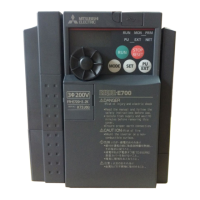
What to do if Mitsubishi Electric Inverter experiences output phase loss?
If your Mitsubishi Electric Inverter experiences an output phase loss, wire the cables properly.
What to do if Mitsubishi Electric FR-E720-0.1K(SC) Inverter trips due to overcurrent during acceleration?
If the Mitsubishi Electric Inverter trips due to overcurrent during acceleration, increase the acceleration time.
What to do if Mitsubishi Electric FR-E720-0.1K(SC) Inverter trips due to overcurrent during deceleration or stop?
If your Mitsubishi Electric Inverter trips due to overcurrent during deceleration or stop, increase the deceleration time.
What to do if Mitsubishi Electric FR-E720-0.1K(SC) trips due to regenerative overvoltage during deceleration or stop?
If the Mitsubishi Electric Inverter trips because of regenerative overvoltage during deceleration or stop, increase the deceleration time.
What to do if Mitsubishi Electric Inverter trips due to regenerative overvoltage during constant speed?
If your Mitsubishi Electric Inverter trips due to regenerative overvoltage during constant speed, keep the load stable.
What to do if Mitsubishi Electric FR-E720-0.1K(SC) Inverter experiences output side earth (ground) fault overcurrent at start?
If your Mitsubishi Electric Inverter experiences an output side earth (ground) fault overcurrent at start, remedy the ground fault portion.
What to do if Mitsubishi Electric FR-E720-0.1K(SC) Inverter indicates input phase loss?
If your Mitsubishi Electric Inverter indicates an input phase loss, wire the cables properly.
What to do if Mitsubishi Electric FR-E720-0.1K(SC) experiences stall prevention stop?
If your Mitsubishi Electric Inverter experiences a stall prevention stop, reduce the load weight.
What to do if Mitsubishi Electric FR-E720-0.1K(SC) shows heatsink overheat?
If your Mitsubishi Electric Inverter displays a heatsink overheat warning, set the surrounding air temperature to within the specifications.
How to fix write disable error on Mitsubishi Electric Inverter?
To resolve a write disable error on your Mitsubishi Electric Inverter, check the setting of Pr. 77 Parameter write selection.
| Brand | Mitsubishi Electric |
|---|---|
| Model | FR-E720-0.1K(SC) |
| Category | Inverter |
| Language | English |
Verifies the inverter model, capacity, and serial number match the order and ensures the product is intact.
Lists necessary peripheral devices for inverter installation and operation, including reactors, filters, and brake units.
Provides instructions for safely removing and reinstalling the front and wiring covers of the inverter.
Details enclosure design considerations, environment, cooling, and placement for proper inverter installation and operation.
Explains basic wiring procedures, including terminal connections and diagrams for standard and safety stop models.
Details main circuit terminals, power supply, and motor wiring arrangements for different voltage classes.
Provides specifications for control circuit terminals, including input signals, output signals, and communication interfaces.
Explains how to connect optional units like brake resistors, brake units, and converters to the inverter.
Discusses electromagnetic interference (EMI) and leakage currents, and provides measures for suppression.
Explains the necessity and method of installing power factor improving reactors to prevent damage from peak current.
Details the purpose and handling of magnetic contactors on the inverter's input side for safety and maintenance.
Provides measures to prevent surge voltage deterioration of insulation when driving 400V class motors.
Offers essential points to recheck before operation to prevent product damage or shortened lifespan.
Describes how to provide an interlock using inverter status output signals to prevent accidents during inverter failure.
Details the components and functions of the inverter's operation panel for setting and monitoring.
A comprehensive list of all parameters, their settings, and related pages for easy reference.
Explains the different control modes available, including V/F and magnetic flux vector control.
Covers methods for adjusting motor torque to improve performance, especially at low speeds.
Covers methods for setting upper and lower limits for the inverter's output frequency to protect the system.
Describes how to select and adjust V/F patterns for different load characteristics.
Explains how to set frequency using external signals like multi-speed or jog commands.
Covers setting acceleration and deceleration times and patterns for smooth motor control.
Covers selecting the correct motor and applying protective functions.
Covers methods for motor braking and stopping, including DC injection brake and regenerative braking.
Details how to assign functions to the inverter's input and output terminals.
Covers how to display and monitor various inverter operating parameters.
Covers settings for automatic restart and controlled stops during power interruptions.
Covers how to configure the inverter's behavior when faults occur, including retry functions and phase loss protection.
Covers features designed to reduce energy consumption.
Addresses methods to reduce motor noise, EMI, and mechanical resonance issues.
Covers how to use analog signals for frequency setting and control.
Covers functions to prevent accidental parameter changes or misoperations.
Covers selecting the inverter's operation mode and control location.
Details the procedures for resetting the inverter after a fault or alarm occurs.
Provides a reference list of all possible fault and alarm codes displayed by the inverter.
Lists common causes of faults and alarms with corresponding corrective actions.
Shows the mapping between digital codes displayed on the operation panel and their actual alphanumeric representations.
Offers initial troubleshooting steps for common problems before delving into specific causes.
Outlines the essential checks for daily and periodic maintenance to ensure inverter reliability.
Details procedures for measuring electrical parameters of the inverter's main circuit.
Provides detailed electrical ratings and applicable motor capacities for various inverter models.
Lists common specifications applicable across the inverter series, including control methods and environmental requirements.
Shows the physical dimensions and mounting hole locations for different inverter models.
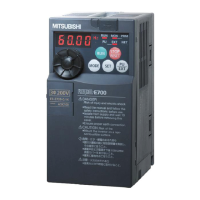
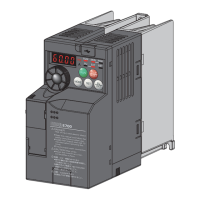
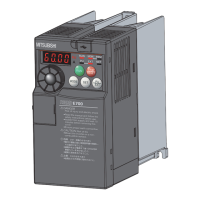








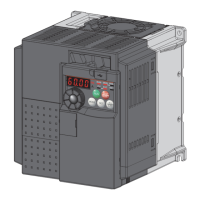
